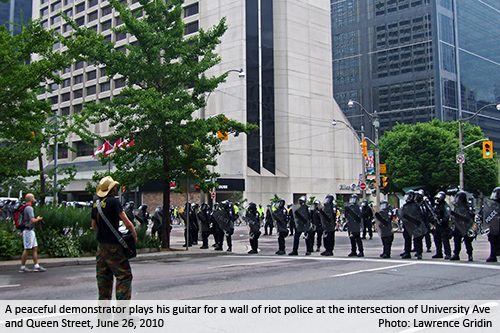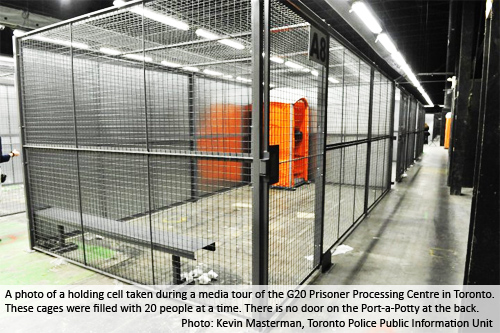The G20 summit in Toronto has come and gone, but not before leaving a trail of destruction in its wake. Â I’m not just referring to all the shattered glass and burned out husks of police cars; I’m talking about Torontonians’ faith in the rule of law.
Our Ontario police forces, particularly the Toronto Police Service, are some of the finest and most professional in the world. They have worked hard to build community relations and win the respect of the public. Just as we rely on the police to keep us secure, the police rely on public cooperation to effectively do their jobs.
When the public trust in police is diminished, and people begin to see the police as an enemy, it puts our safety in jeopardy. That is precisely what is happening. The police are coming under heavy criticism for the perceived overzealous tactics they used this weekend. I have heard of many strong supporters of the police, some of whom were caught up in the mass detentions, beginning to question whether their support was misplaced.
The front page of the Office of the Independent Police Review Director’s website has been changed to add a special notice about G20-related complaints. I suspect the new bureaucratic agency will have to expand just to handle all of them.
Preliminary reports of apparent civil rights violations are coming in from all over the city. The Canadian Civil Liberties Association says that these were not isolated incidents.
I saw many with my own eyes. I was in downtown Toronto to take photos of this once-in-a-lifetime event. What I saw terrified me and broke my heart.
The disgraceful actions of a relatively small, hardcore group of criminals running amok in the city have been used to justify the biggest suspension of civil liberties in Toronto’s history.
Peaceful protesters and onlookers at the designated “free speech zone” in Queen’s Park were attacked with batons, pepper spray, and rubber bullets with little or no warning (I was there; I heard none). Nine hundred people were rounded up and arrested, including credentialed journalists, pedestrians walking their dogs, and even a TTC worker in full uniform. Ordinary people at Queen and Spadina were surrounded on all sides by riot police. One by one, seemingly for no reason at all, people were snatched from the trap by force and then disappeared behind a wall of riot police. The fear is vividly captured in this video (watch the whole thing or just  skip ahead to 7:30).
Those arrested were taken to the Eastern Ave. Detention Centre, a specially constructed temporary facility. What happened inside that facility is not yet fully known. Openly homosexual and transgendered people allege that they were segregated into separate cells by homophobic police. Women have made shocking accusations of being threatened by their jailors with rape. The unconfirmed allegations made by Amy Miller in this video are so terrifying that they defy belief.  At the very least, corroborated reports describe the conditions inside as deplorable:
Cramped and filthy cells, mismanagement and disorganized paperwork, lack of food, water and toilet paper, and denial of legal aid and access to lawyers.
Taylor Flook said she spent almost 24 hours in detention before being released without charge and witnessed strip searches of women by male officers, as well as sexist remarks made by several officers.
Hundreds of people have since been released without charge; the vast majority of those arrested weren’t doing anything illegal in the first place!
And then there was the controversial G20 security law. A regulation, quietly passed by the Ontario cabinet under the Public Works Protection Act, empowered police to stop and search anyone attempting to enter the G20 security perimeter. Police Chief Blair now admits that he deliberately misled the media and public as to the scope of the law. He claimed (and the media reported) that it covered a 5-meter area outside of the fence. In fact there were only a few areas outside of the fence which were covered by the regulation. I was misled too (hey, I can admit a mistake).
Trouble is, apparently the Chief failed to tell his own officers about the limited scope of the law. They were enforcing that law all over Toronto, even though it didn’t apply there. When pedestrians far from the security zone were stopped by police, and demanded to know the source of the police authority, they were told: “Public Works Protection Act, you can look it up.” I myself saw people stopped and searched in this manner.
Closer to the security zone, people who were just cycling by, with no intention of trying to enter, were stopped and told they had to surrender their bags for a search or be arrested. Despite the Chief’s claims that “if they refuse and they have the right to refuse, then they leave and they will leave without being arrested,” these people had no option to leave.
Elsewhere, people were stopped on the street and subjected to searches without reasonable suspicion that they were involved in a criminal offence. They were told they were under investigative detention. In the video below, a woman is stopped at King and University (a fair distance from the security zone) and told she must submit to a search of her bags or face arrest. While the officer was polite and respectful, I’ll let you decide whether he violated ss. 8, 9, and 10(b) of the Charter (hint: see R. v. Mann, 2004 SCC 52 and R. v. Suberu, 2009 SCC 33).
After what I saw this weekend, I believe that the government must call a public inquiry into what happened. I fear we will discover that civil liberties throughout Toronto were effectively suspended — the most troubling encroachment on civil rights in Canada since the FLQ crisis. There are lessons to be learned. The police have admitted that mistakes were made. We must have a full accounting of those mistakes to ensure that they are not repeated.





Your point in the beginning is most important: the police destroyed community relations in one weekend. If the police cannot trust the community, why should the community trust the police?
It’s somewhat of a catch-22.
Yes, I think we can agree that random search and seizure is not what we would like our police to do. This is something to incite fear into groups of people and presumes guilt where there is none.
However, after seemingly harmless people began to set police cars ablaze and smashing windows, not to mention the public outcry of “why didn’t the police stop them?” or “why didn’t the police search them?” – By Saturday morning they hadn’t done anything either. And then they did.
These extracurricular powers by the police were granted because of the G20.
These are not powers granted because the provincial government felt like it. These are not powers granted because it was Saturday. This is not a curfew. There is no military coup in progress.
Should Toronto host the G20 again, I don’t particularly want more police cars burned. If the method to stop that is to search everyone that comes near a potential threat area – ok. By going there, I tacitly agree to be searched.
I wasn’t anywhere near University Ave. I wasn’t detained. Problem solved.
Many Torontonians avoided downtown Toronto. Loss of business income. Problem solved.
Remember next time, the police may identify a potential threat area as covering the whole city, province, or country.
“Papers!”
Dave:
I hope you realize that, to use your words, all of downtown Toronto was declared a “threat area.” People live down there. People work down there. Are they supposed to lock themselves in their homes because the Federal government decides to hold a conference a few km away?
All I know is that I’m highly skeptical that there’s a Charter right to shop:
The fundamental problem is that the definition under the PWPA is that a “public work” contemplates landmarks, such as any “railway, canal, highway, bridge, power works…” or a “building”. The (now expired) PWPA Regulation referred to a bounded territory or area demarcated by a fence that, as you rightly point out, is not seamless. The ambiguity in the Regulation relating to the parameters of the security fence perimeter or “public work zone” is troublesome. What is equally, if not more, worrisome, in my view, is the fact that neither the Ontario provincial government, which passed the regulation, nor the Chief of Police, who is charged with enforcing the law, understand where the line is drawn. First it’s “outside”, next it’s “inside”. This is a red herring. The tactic was to strike fear into the minds of protesters thinking of leading the march towards the G20 security fence: the old” “Show us your papers!” routine. This type of ex post facto rationalization is more than a political embarrassment. It exposes a complete disdain for the principles of representative democracy, civil liberties and freedom of political expression.
This officer treated you with the utmost respect. This is an embarrassment to activists like me. I agree I would not want to be searched but my father is a lawyer and he said the officer had every legal right based on what he had indicated. Time to get off your high horse….these people risk there lives everyday. Do you?
Rita:
First of all, I (the author) am not the person depicted in the video.
Secondly, the fact that these people (the police) risk their lives for us does not entitle them to disregard our civil liberties. Police deserve our respect for the hard, dangerous work that they do. But there is no reason why that work cannot be done within constitutional limits that have been set by our legislators and courts. By respecting the balance between law and order on the one hand, and civil rights on the other, the police can do their part to maintain a society that is not only safe, but just and free as well.
Thirdly, I don’t know what kind of lawyer your father is, but I’d have to disagree with his opinion. You’re welcome to read the Supreme Court of Canada cases that I’ve cited above and come to your own conclusions.